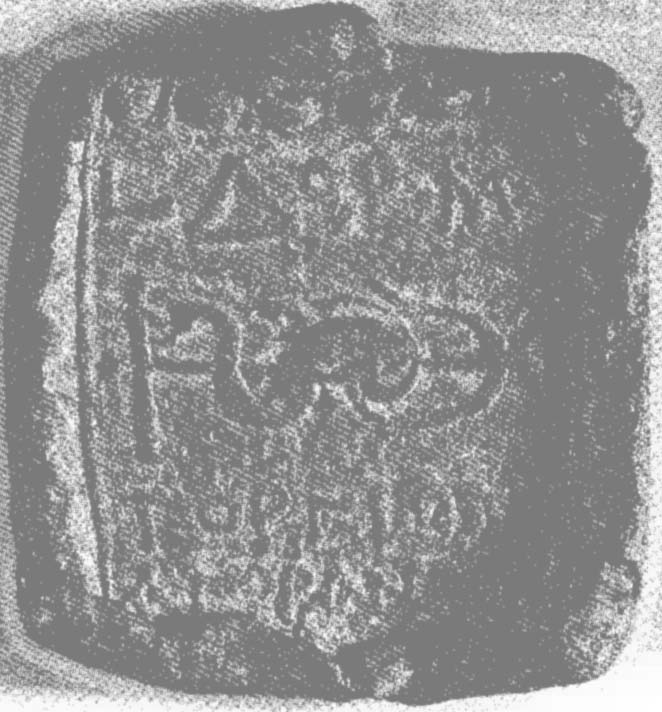
-
Copyright credit: Kushnir-Stein 2005 / U. Fisher

ARCHAEOLOGICAL DESCRIPTION OF THE WEIGHT
Authority
Gorgias I, agoranomos (Berytos)
Mint
Berytos
Denomination
1 Mina
Material
Lead
Manufacture
Cast
Shape
Square
Length
8.20 cm
Width
7.60 cm
Height
1.20 cm
Metrology
| Mass (g) | Mass (grain) | Date of measurement | Reference | fragmented | cleaned | reference weight |
|---|---|---|---|---|---|---|
| 522.20 | - | - | Kushnir-Stein 2005 | No | No | Yes |
Iconography
| Symbol | Technique | Direction | Position | Number | Synecdoche |
|---|---|---|---|---|---|
| Dolphin | Relief | RIGHT | |||
| Anchor | Relief | RIGHT | |||
| Egg and dart pattern | Relief | ||||
| Lattice pattern | Relief |
Wear
Corrosion
Handle
Yes
Suspension hole
Yes
Recarved mould
No
Recarved weight
No
Intentionally destroyed
No
Archaeological description
Kushnir-Stein 2005: This square lead weight has a handle at the top that is now bent toward the side with the inscription. Measurements: 8.2 × 7.6 × 1.2 cm; weight: 522.2 g. One side of the weight has a network pattern that is now very worn and hardly visible. The other side has raised borders decorated on all four sides with an ovolo design on the inner side of the border. Below the ovolo design is a square frame, in the center of which is a dolphin entwined around a horizontally placed anchor. There is a one-line inscription above the dolphin, and a two-line inscription below it.
Autopsy
No
INSCRIPTION
| Language | Technique | Legend type |
|---|---|---|
| Greek | Relief | Authority, Date, Denomination |
Fac simile
LΔϘΡΜ῀
ΓΟΡΓΙΟΥ
ΑΓΟΡΑΝΟΜΟΥ
Edition
(Ἔτους) δϙρ´ μ(νᾶ) | Γοργίου | ἀγορανόμου.
Monogram
ARCHAEOLOGICAL CONTEXT
Findspot (region)
Findspot (site)
context
CIRCUMSTANCES OF ACQUISITION
Region
City
Date of first acquisition
circumstances
DATING OF THE WEIGHT
Curatorial Section
GREEK
Time frame
FROM
-119
TO
-118
Comments on Chronology
SE 194 = 119/118 BCE
COLLECTION HISTORY
Collection
| Name | Date of acquisition | Inventory number |
|---|---|---|
| Hecht Museum – University of Haifa | None | H-3312 |
Bibliography
| Reference | Page/Column | Reference (number) | Plate / Figure | Comment |
|---|---|---|---|---|
| Kushnir-Stein 2005 | 16*–18* | 2 | fig. 2 | None |
| SEG 55 | None | 1697 | None | (non vidi) |
| BÉ 2007 | 749 | 510 | None | None |
| Finkielsztejn 2012 | 142 | 31 | None | None |
| Gatier 2014 | 153–154 | None | None | None |
| Finkielsztejn 2015 | 80–82 | 122 | None | None |
| IGLS VIII/1 | None | None | None | None |
VARIA
Additional comment
Kushnir-Stein 2005: The meaning of the sign in the upper-right corner of the weight is not entirely clear. It consists of the letter mu (M) and a straight line joined to the upper end of its right bar on the right. The right bar of the M is not strictly vertical; rather, it goes diagonally from the upper left to the lower right. The straight line joins it at an angle of close to 90 degrees. Thus the combination of the right bar of the mu and the straight line could be understood as the letter gamma (Γ). This, however, is not the only way to interpret the sign. [...] In the light of all these parallels, the line joining the upper end of the letter M on our weight may have also been intended to indicate that a weight unit is meant. The M would, then, signify that this is a mina. The weight of our item is 522.2 g, which is less than the average weight of the Seleucid mina. However, given the extensive wear of the reverse side and the damage in various other places, the original weight of the item must have been doser to the standard. The place where our weight was manufactured thus seems to have employed the Seleucid mina as its basic weight unit.
Kushnir-Stein 2005: The only difference between our weight and those of Berytus is that the latter display a trident alone or a dolphin entwined around a trident, whereas on our weight a dolphin is entwined around an anchor. So far, no weights or coins with exactly the same design have been attributed to any city in Phoenicia or Palestine. Given the man y similarities between our weight and those from Berytus, then, our weight is likely to have originated either in this city or in a locality in close proximity to it.
Kushnir-Stein 2005: The only difference between our weight and those of Berytus is that the latter display a trident alone or a dolphin entwined around a trident, whereas on our weight a dolphin is entwined around an anchor. So far, no weights or coins with exactly the same design have been attributed to any city in Phoenicia or Palestine. Given the man y similarities between our weight and those from Berytus, then, our weight is likely to have originated either in this city or in a locality in close proximity to it.
Permalink
External link